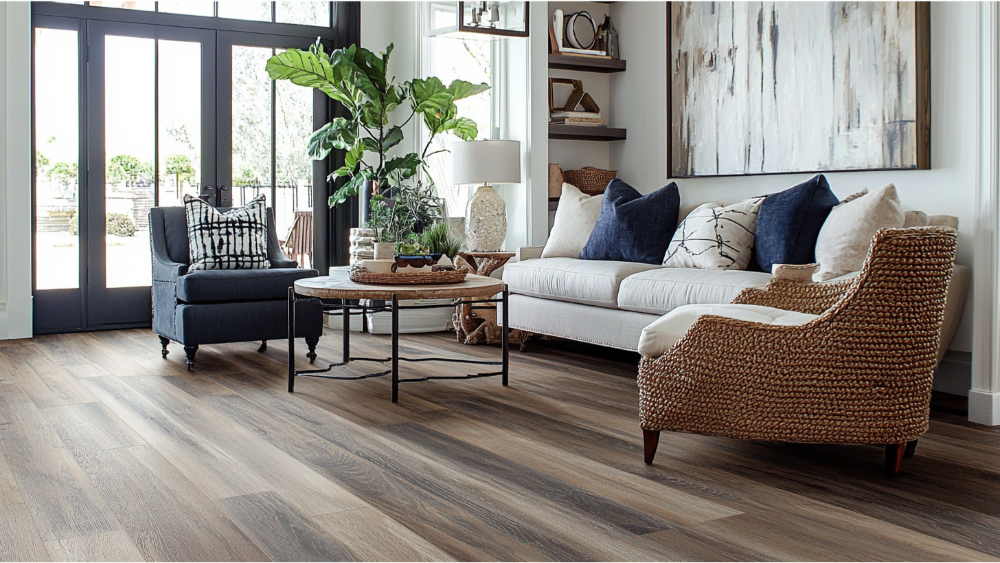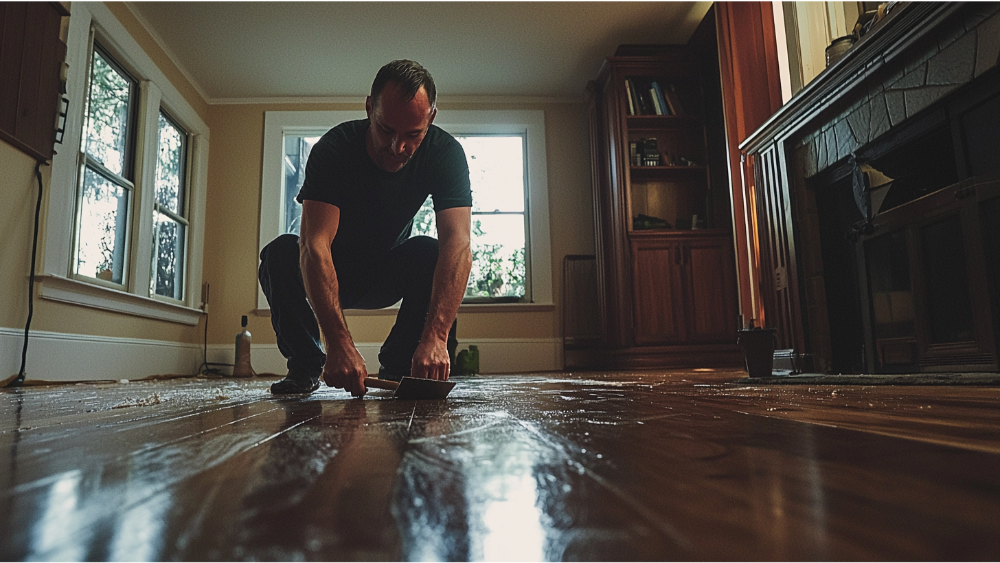When choosing between LVP (Luxury Vinyl Plank) flooring and laminate, it’s essential to understand the key differences to make the best decision for your space. Both options offer affordability and a wide range of styles, but they differ in durability, water resistance, and maintenance. This guide will help you compare the two to find the perfect fit for your needs.
What is LVP Flooring?
LVP flooring, or Luxury Vinyl Plank, is a highly durable and versatile flooring option designed to mimic the look of natural materials like hardwood or stone. It is constructed from several layers, including a wear layer that protects against scratches, stains, and daily wear, making it ideal for high-traffic areas.
Unlike many other flooring options, LVP is water-resistant or even fully waterproof, making it a popular choice for kitchens, bathrooms, and basements. Its ease of installation and low-maintenance upkeep appeal to homeowners seeking practicality and style in equal measure.
What is Laminate Flooring?
Laminate flooring is a cost-effective alternative to hardwood, featuring a photographic layer that provides a realistic wood or stone aesthetic. It is composed of a high-density fiberboard base topped with a protective wear layer, which adds durability against wear and tear.
While both laminate and LVP are known for their visual variety, laminate flooring lacks the waterproof properties of LVP, making it less suitable for spaces with high moisture exposure. It remains an attractive choice due to its affordability, easy installation, and range of design possibilities that enhance any room’s appearance.
Side-by-Side Comparison of LVP Flooring and Laminate Flooring
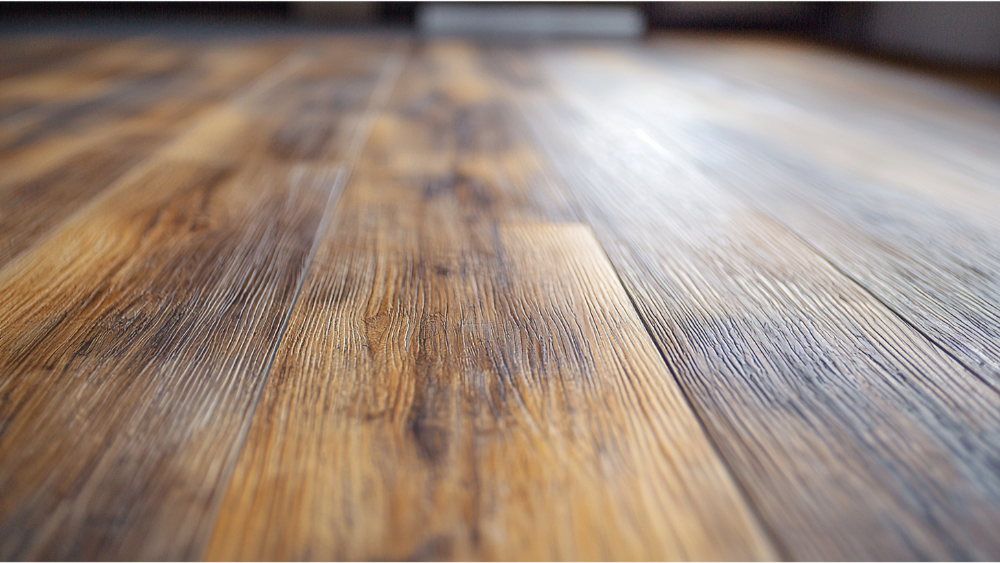
Durability
Luxury vinyl flooring, or LVP, is renowned for its exceptional durability, withstanding heavy foot traffic, scratches, and impacts without losing its appearance. Its multiple protective layers, including a tough wear layer, contribute to its lasting resilience.
Compared to natural wood or hardwood floors, laminate flooring, while also durable, is more susceptible to damage like chipping or swelling when exposed to moisture. This makes LVP a better choice for families with pets, children, or demanding environments.
Water Resistance
One significant advantage of vinyl plank flooring is its water-resistant or even waterproof properties, making it an ideal solution for kitchens, bathrooms, and laundry rooms. Laminate flooring, on the other hand, lacks this level of moisture protection and can warp or swell if exposed to water.
While some high-end laminate options offer improved moisture resistance, they still cannot compare to the reliable performance of luxury vinyl plank flooring. For areas prone to spills or humidity, LVP provides peace of mind and longevity.
Installation
Both LVP and laminate flooring are often installed as floating floors, making them excellent options for DIY enthusiasts. Floating floors do not require adhesives or nails, simplifying installation and reducing the time needed to complete a project. LVP, however, can also come in peel-and-stick or glue-down installations, offering even more flexibility.
Laminate requires precise cutting and fitting, while LVP’s more forgiving material can be easier to work with for beginners. Additionally, LVP’s rigid core design enhances stability, making it a reliable choice among different flooring types.
Aesthetic Options
Laminate flooring excels in providing realistic and detailed natural wood or stone visuals thanks to its high-resolution photographic top layer. Luxury vinyl flooring, however, rivals this with its realistic finishes and 3D textures that closely replicate natural wood and other materials.
LVP’s availability in planks, tiles, or even sheet vinyl means it offers a broader range of aesthetic versatility for different design needs. Whether seeking a warm wood style, sleek stone appearance, or sophisticated look that highlights wood byproducts, both options can effectively transform a space.
Maintenance
Vinyl flooring, especially LVP, is incredibly low maintenance, requiring only simple cleaning like sweeping or mopping. Its water resistance ensures spills can be easily wiped away without damage to the flooring. Laminate floors necessitate more care, as excess water can seep into the seams and cause issues over time.
For homeowners seeking a practical, hassle-free flooring option, luxury vinyl flooring offers unbeatable convenience. Its stain resistance further adds to its appeal, making it a worry-free choice for high-traffic areas.
Cost
When comparing cost, laminate flooring generally has a slight edge in terms of affordability. It is often one of the most budget-friendly flooring types, making it accessible for homeowners on a tighter budget. LVP flooring, while typically more expensive per square foot, offers greater durability and water resistance, which can translate into long-term savings by avoiding potential repairs or replacements.
Whether you prefer natural wood aesthetics or the versatility of vinyl plank, both options provide excellent value for their price, but the initial investment may depend on your immediate financial considerations and the specific needs of your space.
Environmental Impact
Laminate flooring tends to be more environmentally friendly due to its composition, which often includes wood byproducts and recycled materials. However, it is not entirely eco-friendly, as it may release volatile organic compounds (VOCs) during installation.
LVP flooring is less sustainable, as it is made from synthetic materials like PVC, which have a more significant environmental impact during production. That said, some manufacturers are now offering eco-friendly LVP options with lower VOC emissions. If sustainability is a priority, be sure to research products from manufacturers committed to greener practices in flooring types like vinyl plank or laminate.
Pros LVP Flooring
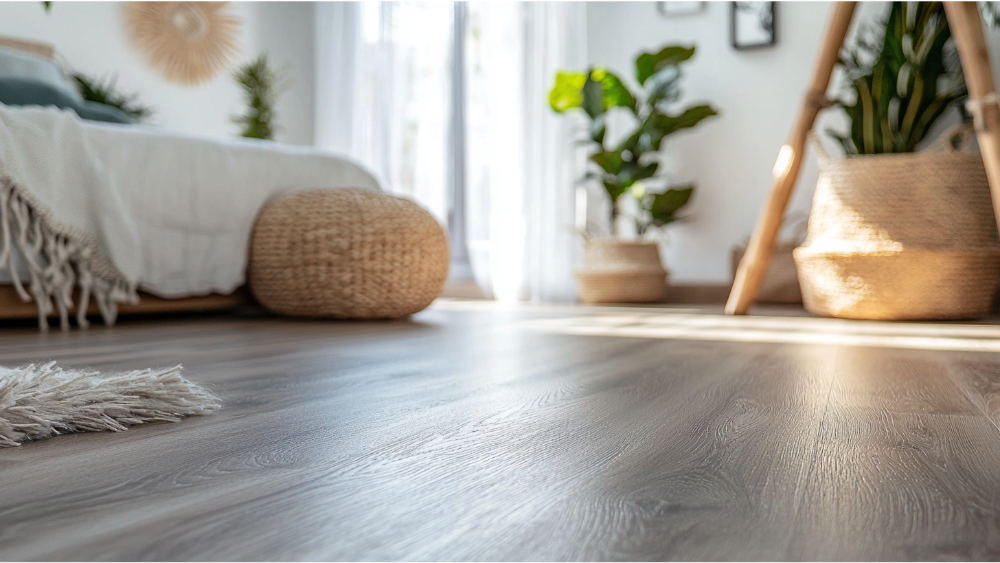
Waterproof and Durable
LVP is fully waterproof, making it ideal for rooms with high moisture levels like bathrooms and kitchens. Its resilience ensures long-term durability even in high-traffic areas. The protective layers, including its image layer, help retain a pristine appearance despite daily wear and tear.
Comfort and Quietness
LVP often provides a softer feel underfoot due to its construction and added underlayment options. This makes it comfortable for standing over extended periods, such as in the kitchen. Its construction also aids in sound absorption, reducing noise levels compared to harder flooring surfaces.
Ease of Cleaning
Maintenance for luxury vinyl plank is incredibly simple, as it resists stains and spills can be wiped away effortlessly. Its resistance to scratches ensures it retains a polished look with minimal upkeep required. These features make it a practical choice for families or busy environments.
Cons LVP Flooring
Higher Installation Costs
While suitable for DIY installation, LVP can sometimes involve higher costs depending on installation methods such as glue-down options. Floating floor installations may save money, but base preparation is crucial for ideal results. Factors like underlying uneven surfaces can add additional labor and expenses.
Synthetic Material Composition
As a PVC-based product, its production has a greater environmental impact compared to some natural or recycled alternatives. There are eco-friendly options, but these may come at a higher price point. Individuals concerned about sustainability may find this aspect limiting.
Temperature Sensitivity
LVP can expand or contract with extreme temperature variations. This sensitivity may lead to the need for careful installation and acclimation to avoid issues over time. For climates with significant temperature fluctuations, proper planning is essential.
Pros Laminate Flooring
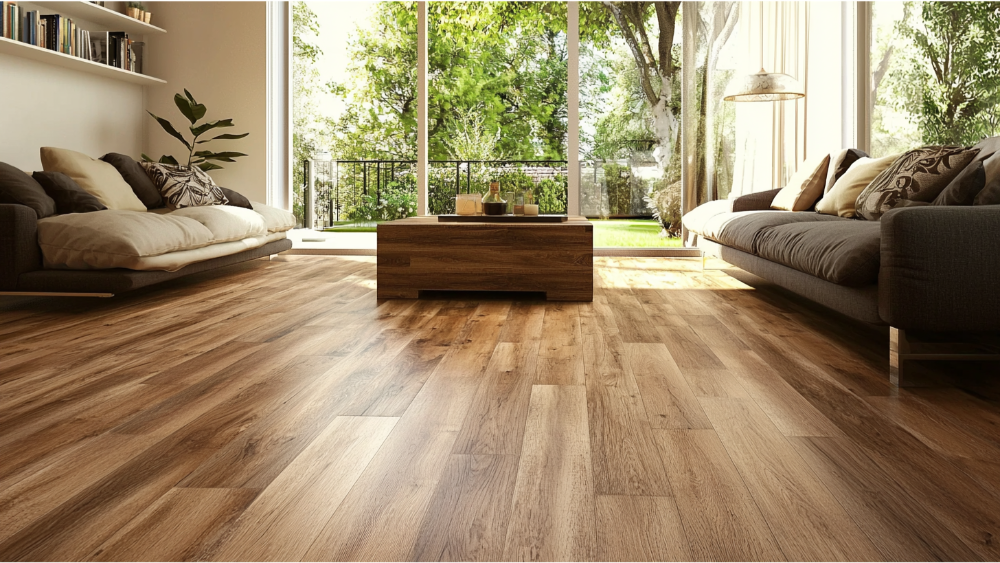
Authentic Aesthetic Options
Laminate excels in mimicking natural wood or stone with its high-quality photographic image layer. The resolution and detailing create a realistic look that enhances any room’s design. These aesthetically pleasing finishes make laminate a favored choice for achieving premium visuals at a lower cost.
Cost-Effective Solution
Laminate flooring offers a budget-friendly option compared to many other flooring types. Its installation costs are generally lower, especially for DIY enthusiasts. For projects with tighter financial constraints, laminate offers great value without compromising style.
Durable and Scratch-Resistant
Despite its lower price, laminate provides strong scratch resistance, keeping its surface looking new for longer. This durability makes it a viable choice for homes with pets or children. Its protective topcoat prevents general wear and tear, adding to its longevity.
Cons Laminate Flooring
Moisture Sensitivity
Laminate flooring is not waterproof and can warp or swell when exposed to water. While some premium versions offer better moisture resistance, they still fall short against LVP’s performance in wet areas. Extra care is necessary to maintain its integrity, limiting its use in certain spaces.
Harder Surface Underfoot
Laminate flooring lacks the softer feel underfoot that LVP offers. This may make it less comfortable for prolonged standing, particularly in areas with heavy use like kitchens. It also provides less sound absorption, which can lead to louder environments.
Challenging Repairs
Damage to laminate, such as chipping or swelling, is often more complicated to fix. Entire sections may need replacing, adding to maintenance frustrations. This can make it less practical for high-impact areas or homes with active lifestyles.
Frequently Asked LVP Flooring VS Laminate Questions
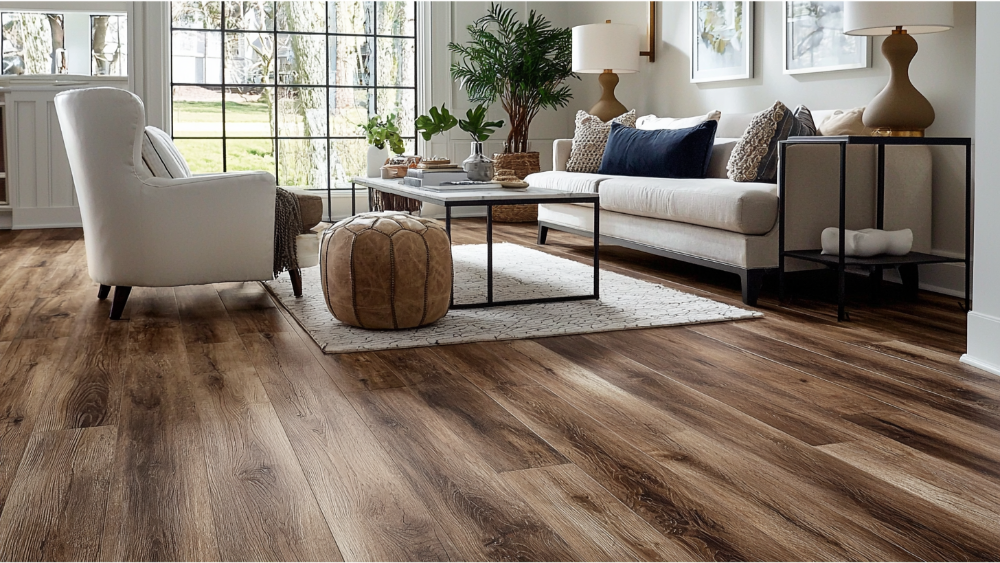
Is LVP Better Than Laminate?
Whether LVP or laminate is better depends largely on your specific needs and priorities. LVP is superior when it comes to water resistance, durability, and comfort underfoot, making it ideal for moisture-prone areas like kitchens and bathrooms. On the other hand, laminate may be a better choice for achieving a natural aesthetic at a more budget-friendly price, especially in spaces with low moisture exposure.
Can Mold Grow Under Vinyl Plank Flooring?
Yes, mold can grow under vinyl plank flooring if moisture becomes trapped beneath it. This is especially likely in cases of improper installation or when water seeps through cracks or gaps. To minimize the risk, ensure the subfloor is dry and level, and use moisture barriers in areas prone to dampness.
Do High-End Homes Use Luxury Vinyl Plank?
Yes, luxury vinyl plank (LVP) is increasingly being used in high-end homes due to its versatility and premium appearance. Modern LVP designs can closely mimic high-end materials like hardwood or stone, offering a sophisticated look with added durability. Its waterproof and low-maintenance features make it a practical yet stylish choice for luxury dwellings.
Conclusion
When deciding between luxury vinyl plank (LVP) flooring and laminate flooring, it’s essential to weigh the pros and cons based on your specific requirements. LVP stands out for its water resistance, durability, and comfort, making it an excellent choice for high-traffic or moisture-prone areas such as kitchens, bathrooms, and basements. On the other hand, laminate provides a cost-effective and realistic aesthetic option for those prioritizing affordability and style in dry environments. Both flooring types offer unique benefits, and your choice ultimately depends on factors like budget, intended use, and desired appearance. By carefully evaluating these aspects, you can select the flooring solution that best fits your needs and lifestyle.


